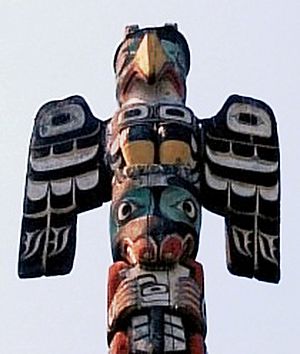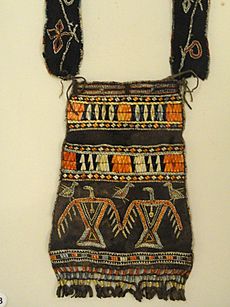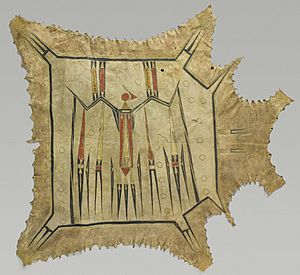Thunderbird (mythology) facts for kids
| Grouping | Legendary creature |
|---|---|
| Similar creatures | Rain Bird, Pamola |
| Mythology | Indigenous peoples of the Americas |
| Region | North America |
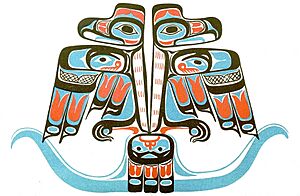
The thunderbird is a powerful legendary creature from the stories and cultures of many Native American peoples in North America. It's seen as a supernatural being with great power and strength.
This creature is very important in the art, songs, and oral histories of many Pacific Northwest Coast cultures. You can also find stories about the thunderbird among peoples in the Southwestern United States, East Coast of the United States, Great Lakes, and Great Plains regions.
Contents
What is a Thunderbird?
People say the thunderbird creates thunder by flapping its huge wings. It also makes lightning by flashing its eyes. These powerful birds are often seen as protectors or as beings that keep balance in the world.
Thunderbird Stories from Different Peoples
Many different Native American groups have their own unique stories about the thunderbird. These stories often share similar ideas about its power and role.
Algonquian Peoples
The thunderbird is a very common figure among Algonquian peoples in the Northeast (like in Eastern Canada and the Northeastern United States) and the Iroquois peoples around the Great Lakes.
In Algonquian mythology, the thunderbird rules the upper world, while creatures like the underwater panther or Great Horned Serpent rule the underworld. The thunderbird creates lightning bolts and throws them at these underworld creatures.
Ojibwe Stories
The Ojibwe people have a myth that says the thunderbirds were created by Nanabozho to fight evil spirits that lived underwater. Thunderbirds also made sure humans followed moral rules. They were believed to live in the four directions and would arrive with other birds in the spring. In the fall, they would fly south when the dangerous season for underwater spirits ended.
Menominee Stories

The Menominee people of Northern Wisconsin tell stories of a huge mountain that floats in the western sky. This is where the thunderbirds live. They control the rain and hail, and they love to fight and do great deeds. They are the enemies of the great horned snakes (called Misikinubik) and have stopped them from taking over the Earth and harming people. The thunderbirds are also seen as messengers from the Great Sun itself.
Siouan Peoples
The thunderbird is also an important symbol for Siouan-speaking peoples, whose tribes traditionally lived around the Great Lakes.
Ho-Chunk Beliefs
In Ho-Chunk tradition, a man who sees a thunderbird during a solitary fast is believed to become a war chief for his people. This shows how highly respected and powerful the thunderbird is in their culture.
Arikara Stories
The Arikara people have a tale called The Boy who befriended the Thunderbirds and the Serpent. In this story, a boy named Antelope-Carrier finds a nest with four young thunderbirds. Their mother tells the boy that a two-headed Serpent comes from the lake to eat the young birds, showing the thunderbird's role in protecting its family.
How Thunderbirds are Shown in Art
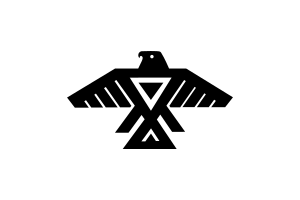
In art, especially among Algonquian peoples, the thunderbird is often shown in a special X-shape. This means its wings are spread out to the sides, and its head is facing forward.
Sometimes, the thunderbird is shown in a very simple, artistic way. An X-shaped thunderbird without a head was found on an Ojibwe midewiwin disc from long ago (1250–1400 CE). Even in an 18th-century book, drawings of the thunderbird changed from clear birds to just an X shape.
Thunderbirds in Modern Culture
The thunderbird has inspired many things in modern times:
- In the popular video game Tom Clancy's Rainbow Six: Siege, there's a character named Thunderbird.
- The famous Ford Thunderbird car was named after this legendary creature.
- In 1925, Aleut people used the term "thunderbird" to describe the Douglas World Cruiser aircraft. This was an airplane that flew through Atka during the first aerial circumnavigation by a US Army team.
- The Pokémon Zapdos is based on the thunderbird from First Nations folklore.
- The thunderbird is also part of the Harry Potter franchise. It plays an important role in the movie Fantastic Beasts and Where to Find Them.
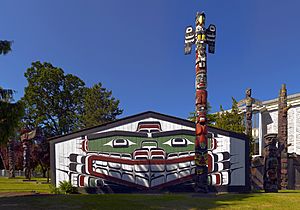
See also
 In Spanish: Pájaro del trueno para niños
In Spanish: Pájaro del trueno para niños
- Lightning bird
- Pamola
- Piasa
- Rain Bird
- Raven (mythology)
- Roc (mythology)
- Thunder god
- Timeline of pterosaur research


